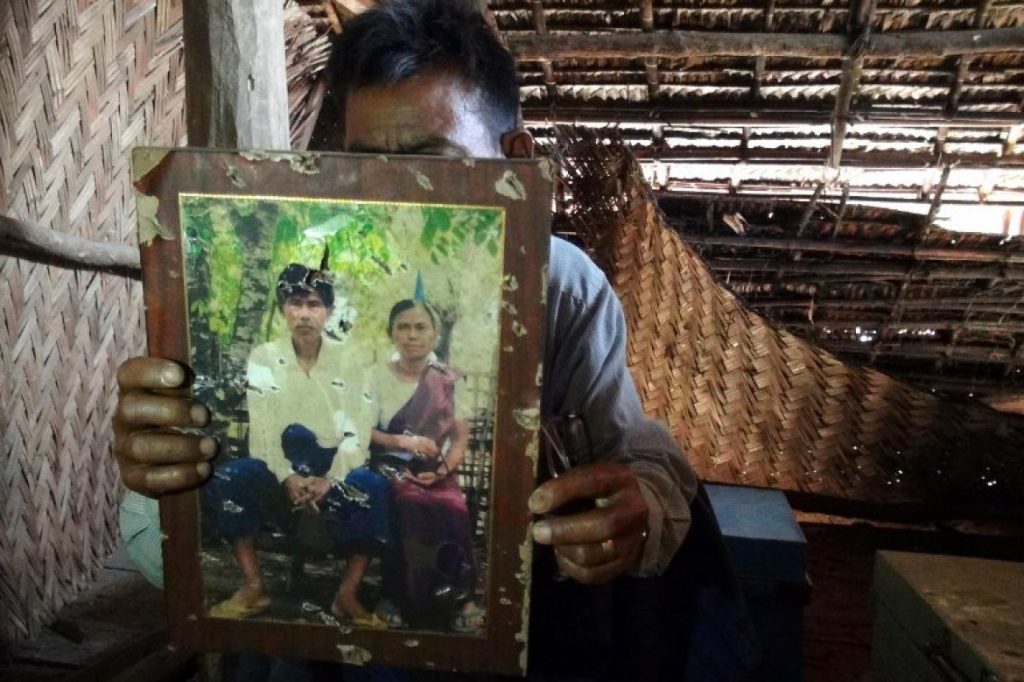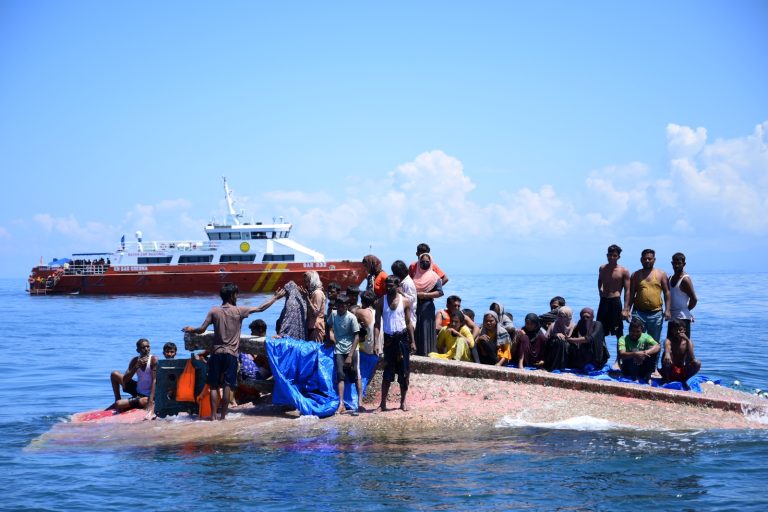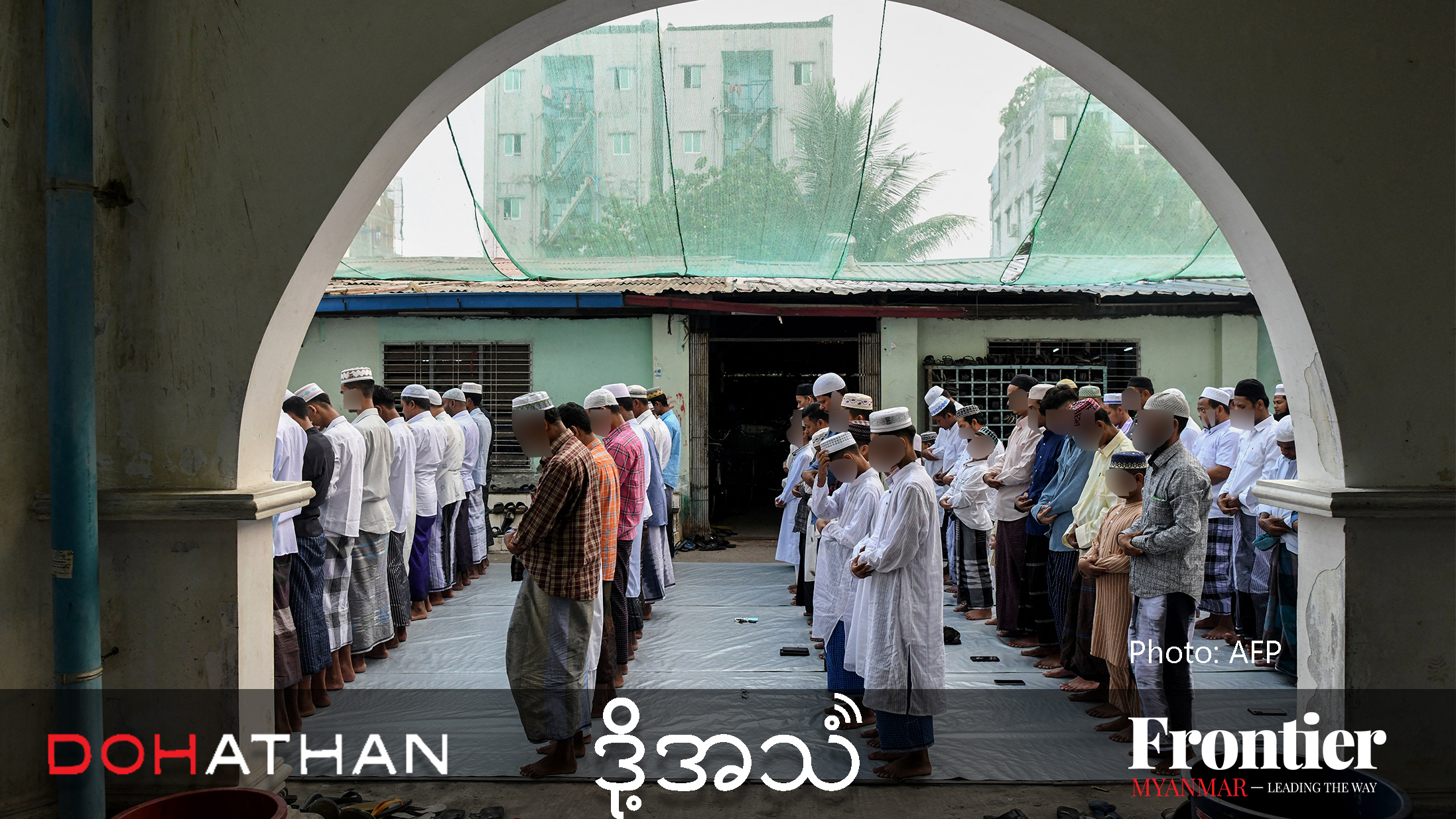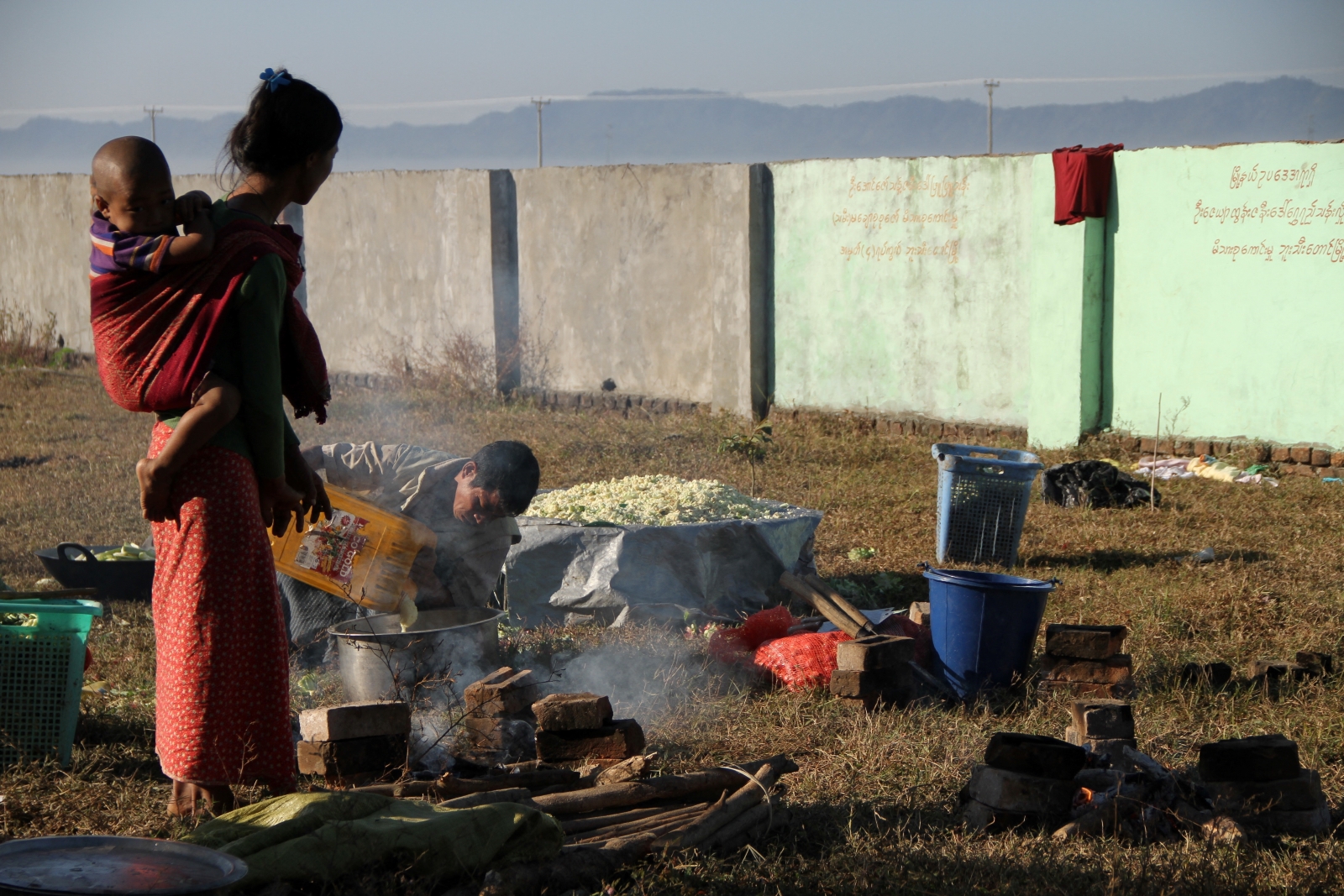The response from the government and military to the Arakan Army’s January 4 attacks is disproportionate and bound to backfire by strengthening support for the AA within Rakhine State.
By THIHA WINT AUNG | FRONTIER
Recent armed clashes between the Tatmadaw and the Arakan Army in the wake of the ethnic armed group’s January 4 attacks have displaced thousands of people, creating yet another humanitarian crisis in Rakhine State.
Given the response from the National League for Democracy government and military, the armed conflict in Rakhine State is likely to worsen over time. In the immediate aftermath they labeled the AA a “terrorist” group, and the President’s Office ordered the military to respond with “clearance operations”. Fighting and arrests of civilians have already been reported.
But this is the wrong strategy, one that plays into the hands of the AA. The expansion of war efforts and the waging of an offensive against the AA would be counterproductive to the NLD government and the Tatmadaw’s interests for three reasons.
The first is that, if the Tatmadaw wages a military offensive against them, the AA will gain legitimacy and the support of the Rakhine public. The second reason is that this strategy has already been tested – against the Arakan Rohingya Salvation Army, for example – and has resulted in harm to the image and reputation of the government and the Tatmadaw.
Support more independent journalism like this. Sign up to be a Frontier member.
Last but not least, such military operations would only worsen existing ethnic tensions in Rakhine State, which would backfire on both the NLD government and the Tatmadaw in the long run. The AA’s power to inflict “political” damage on the Myanmar government and the Tatmadaw is greater than its power to inflict material and infrastructural damage.
The NLD government perceived the AA attacks as a stab in the back while it was working hard to achieve peace and national reconciliation, and also dealing with the fallout from the Rohingya crisis. Government spokesperson U Zaw Htay claimed that the AA was trying to establish a stronghold in Rakhine State. But how exactly would attacking four small police stations establish physical territory for the AA?
Examining the AA’s strategy
While the scale and extent of the damage caused by the January 4 attack was relatively small compared to recent insurgent offensives in the northern and eastern parts of Myanmar, the media coverage and the nationalist fervour (both on the part of the Rakhine public and the rest of the country) that followed the event were significantly greater. This is no accident: immediately after the attack, the AA’s leader, Major-General Tun Myat Naing, and AA spokespersons gave a series of interviews that helped to attract and sustain media coverage.
Moreover, there is clarity in the “political message” conveyed by the AA. The group’s leaders claim that they are fighting for the Rakhine people who have long suffered oppression and poverty in a resource-rich state with a proud history. That message is appealing to the Rakhine public in the sense that it addresses the legitimate grievances suffered by the Rakhine people while providing an alternative – that fighting the Tatmadaw will alleviate the suffering.
Tun Myat Naing stressed that the AA was careful not to inflict any damage on the Rakhine community: “We are very concerned for our Rakhine people. We make sure that our people’s safety is not jeopardised. Not just our people. There are also Muslim villages nearby. When our battalions came across these villages, we assured them not to worry.” He even directly communicated to the Muslim community residing in the area that the AA means no harm to the Muslim villages, something the Tatmadaw and the Myanmar government could not claim with a straight face.
Meanwhile, on the other side of the Rakhine mountains, in Nay Pyi Taw, the Myanmar government and the Tatmadaw scrambled to respond to the AA’s attacks on both the military and political sides. A meeting between the President’s Office and the Tatmadaw’s generals was convened and their solution was simple: eradicate the AA insurgents.
Zaw Htay sent a warning to the Rakhine public, urging them to consider the long-term consequences of supporting the AA. This message is unlikely to resonate with Rakhine people.
Tun Myat Naing also said that the group’s political ambition was to achieve “confederal status”. Why would the AA say something that would clearly provoke the Tatmadaw, who would not even allow the use of the word “federal” until the very recent past?
At this point, we should step back and reflect on the AA’s possible strategy. I would argue that the AA, at this point, is not interested (or is less interested) in establishing physical territory – or, rather, that the AA seems to have other objectives in its strike against the border guard forces. The AA is more interested in occupying the minds of the Rakhine public so it can build public support and gain political legitimacy. Subsequent military offensives by the NLD government and the military are paving the way for this outcome.
Why a full military response would backfire
By responding with full military might and “clearance operations”, the Tatmadaw is bound to cause civilian collateral damage. Its soldiers have already been accused of human rights violations and abuses against Rakhine villagers following their January 14 attack on an AA base.
Even prior to January 4, the AA had said it was documenting human rights violations perpetrated by the Tatmadaw and had vowed to protect the Rakhine people. There have also been reports that some administrators and Rakhine villagers were charged with assisting the AA. Most recently, 26 people were detained in Kyauktaw Township on February 4.
Rakhine civil society organisations have also reportedly been blocked by the military from helping displaced Rakhine villagers, a move that will only heighten the frustration and anger.
The AA will seek to capitalise on these developments, using them to generate wider public support. This is against the interest of the Tatmadaw, which wants to be viewed as the legitimate “Union” force protecting all the people of Myanmar. While it is true that attacks such as those on January 4 undermine the law and order function of the Tatmadaw, I would argue that it does not justify the heavy-handed response.
The attacks disrupted the everyday administration of the government by invoking fear among civilian and police officials. But responding with full military force might equally invoke fear and resentment. In a country with an unfinished nation-building process, the conflict would also worsen the existing ethnic divide.
Why did the NLD government agree to the Tatmadaw’s offensive? Every government wants to preserve law and order, but the NLD seems to have not fully considered the ethnic tensions between the Bamar and Rakhine. The NLD government might also have been frustrated that the AA launched the attacks shortly after the government and the Tatmadaw had made concessions to restart peace talks.
The NLD government also seems to have secured some support from China in dealing with ethnic armed groups. A few days after the attack, Chinese officials met with senior officials from the Kachin Independence Army, the AA’s mentor, to pressure the KIA to join the peace process and to stop its support to the AA. China’s efforts to help the government should not be taken as a sign to ramp up military offensives, which anyway are unlikely to bring the AA to the negotiating table.
Further, a strong military response from the government without clear political communication to the Rakhine public is, in my opinion, bound to have negative political repercussions. The NLD government is already viewed by many ethnic groups as Bamar-dominated. There’s a perception that it is not capable of delivering the change that minority groups need. By approving the Tatmadaw’s attack, the NLD risks furthering the view that it, too, cannot be entrusted with achieving peace and national reconciliation. This could have political consequences for the already stalled peace process, enabling hardliners in ethnic armed groups to strengthen their position.
Time for a charm offensive
The NLD government should go back to its roots. What allowed the NLD to withstand three decades of adversity? It was a firm belief in and commitment to non-violence, democracy and equality that put the NLD at the forefront of the opposition movement and helped the party gain the trust of almost all ethnic groups in Myanmar.
The NLD government cannot and should not take the trust and votes of minority groups for granted. Recent by-elections attest to the fact that minority groups were frustrated with the government’s policies. Many feel they have been betrayed. There is still generally a belief in democratic institutions, but it is quickly evaporating.
There were many incidents at both the national and sub-national levels in which ethnic minority groups felt that the NLD government did not listen to their voices or to the voices of their representatives. There were many clashes between the Rakhine State Hluttaw, controlled by the Arakan National Party, and the Rakhine State government, controlled by the NLD. What would happen if ethnic minority groups no longer felt that their objectives could be achieved through elections and democratic institutions?
If violence and wars were the solution, successive governments in Myanmar, including both democratic governments and military governments, would have achieved peace already. Why would this strategy work for the NLD?
I am not suggesting that the government and the Tatmadaw should let the AA do whatever it wants. My point is that a military response is not the solution. In the worst-case scenario it is counterproductive to the point that it will aggravate the situation further. Even if the AA were defeated decisively, another armed group would just take its place.
The door to the peace table should remain open, even while military operations are being conducted. Zaw Htay has said that the peace discussions will continue and for this the government should be praised. Meanwhile, civilian and military leaders should wage a charm offensive against the Rakhine public and win their hearts. Since assuming office, the NLD government has rightly prioritised the development of Rakhine State. It should clearly communicate to the Rakhine public about its efforts and that it is ready to listen to the grievances and concerns of Rakhine communities.
Moreover, it is crucial that the NLD government engage with Rakhine politicians and invite them to participate in making important political decisions regarding Rakhine State. It is tempting to silence politicians like Dr Aye Maung, who is in jail facing a charges of high treason and incitement, but that is counterproductive in the sense that his arrest only bolstered his image and legitimacy among the Rakhine public. It is more important than ever that the NLD government makes alliances with moderate Rakhine politicians at both the national and sub-national levels.
At the same time, the Rakhine public must benefit from development and infrastructure projects in resource-rich Rakhine state. They must be consulted in natural resource extraction and their concerns must be heard. It is poverty, unemployment and a sense of hopelessness about the future that makes the “armed solution” attractive to young people in Rakhine State. Equally important is that Rakhine people be allowed to express freely their culture and identity within the larger framework of the “Union spirit”. The ethnic divide in Rakhine State needs to be addressed through sharing political power and economic wealth, and respecting cultural diversity.
When there are attacks like these, it is hard not to fall back into old habits and patterns of responding to force with greater force. But in seven decades of conflict in Myanmar, when has more war achieved peace? A military solution alone is bound to backfire, so the NLD government and the Tatmadaw need to consider alternative solutions. A comprehensive response is needed – one that addresses historical grievances as well as present concerns. The complexity of the situation and the uniqueness of Rakhine State must be taken into account in formulating this response.
Editor’s note: An extended version of this article has been published on Tea Circle, a forum for new and emerging perspectives on Myanmar during its current period of political and economic transition. The views and opinions expressed in this article are those of the author and do not necessarily reflect the position or opinion of the Forum of Federations.







